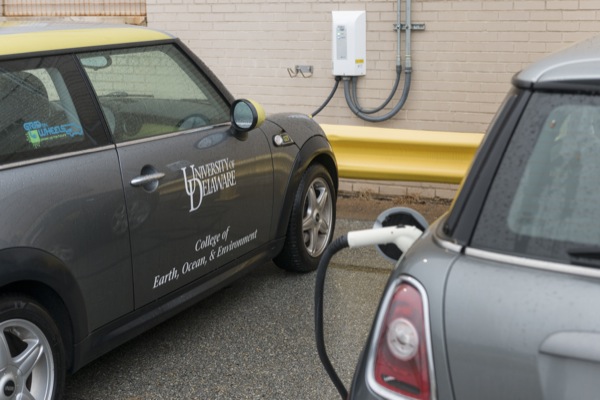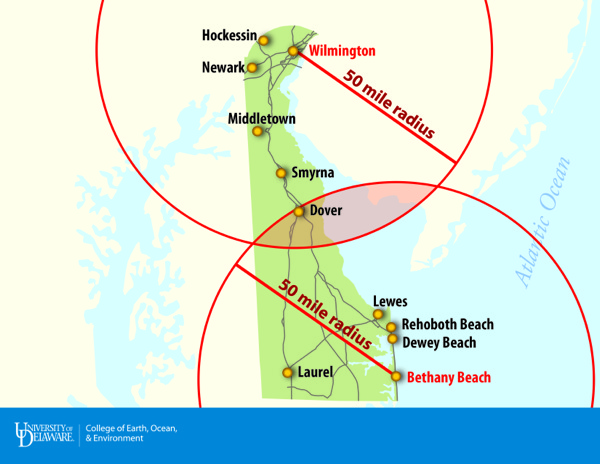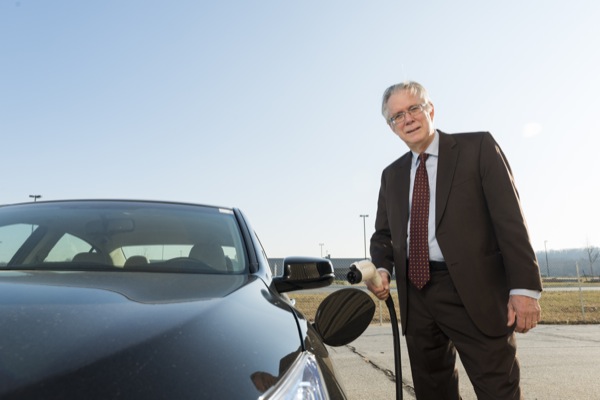


EV charging station expansion
UD, state partner to create electric vehicle charging station network
9:56 a.m., Feb. 19, 2014--Charging stations for electric vehicles will be strategically placed at key locations in Delaware to enable long trips in the state by next year, through a new collaborative research agreement between the University of Delaware and the Delaware Department of Natural Resources and Environmental Control (DNREC).
UD researchers are in the process of determining the most effective locations for charging stations, and they will assist in equipment installation and analyze station usage when the stations become operational. This new infrastructure will support greater use of electric vehicles, which do not release air pollution or carbon dioxide, unlike their gasoline-fueled counterparts.
Research Stories
Chronic wounds
Prof. Heck's legacy
“A well-planned electrical highway in Delaware makes it easier for drivers of electric cars both from Delaware and surrounding states to patronize Delaware tourist destinations – from nightlife on the Riverfront to popular shopping districts to our beaches,” said Nancy Targett, dean of UD’s College of Earth, Ocean, and Environment (CEOE). “Of course, environmentally, air pollution and the need for gasoline are reduced.”
Two years ago, the federal government announced a national goal of 1 million electric vehicles on the roads by 2015. It also announced help to install charging stations, but the latter effort has been sporadic. For example, in the Mid-Atlantic region electric chargers are clustered within metropolitan areas like Philadelphia and Baltimore, but these are not well-located for en-route charging and most are incapable of fast charging.
“Through our innovative partnership with the University of Delaware, our state will help accelerate the widespread adoption of electric vehicles throughout the Mid-Atlantic region and seize both greater air quality and economic development benefits for our state,” said DNREC Secretary Collin O’Mara. “No longer will any Delawareans or visiting owners of electric vehicles have to worry about running out of electricity while traveling in the First State.”
Electric vehicle drivers in Delaware have access to only a few public charging stations. That does not pose a problem for a driver on a typical day – on average, Americans travel 30 miles per day and can charge at home in the evening – but longer trips require either battery recharging en route or a large and expensive long-distance battery.
A ride from Wilmington to Bethany Beach, for example, necessitates a recharge for today’s most economical electric cars, which have small batteries and require charging roughly every 70 miles.
The new project will take into account driver convenience as well as traffic patterns to major destinations in pinpointing locations for five or six new charging stations. Charging a battery from empty to full charge can take from 40 minutes to two hours, depending on the car model, so locations where drivers can spend time dining, shopping or enjoying the outdoors would be carefully considered.
For drivers who just need a boost to go an additional 15 miles, the charge may require only 15 to 20 minutes – time to have a cup of coffee or look at a magazine.
The 16-kilowatt stations will charge two to three times as quickly as more common models, and the service will be offered free-of-charge to users through at least 2014. Willett Kempton, professor in CEOE, and his colleagues will work with public and private location owners on the initial set-up and on a long-term plan, which could include a fee in subsequent years to cover any ongoing costs. The researchers will monitor station usage and track reductions in pollution and carbon dioxide emissions.
The project will help remove a significant obstacle to the adoption of electric cars: “range anxiety.” Potential buyers hesitate to purchase the vehicles for fear that their battery will run out of charge beyond the range of a charging station. Based on prior studies, these stations at key locations will encourage use of electric vehicles, even if the recharge is not actually needed.
The new stations will not be more than 50 miles apart, which is the battery range for the least expensive electric vehicle models today. The program will encourage purchase of such vehicles, which at about $22,000 are about one-fifth as expensive as models with the largest batteries and longest ranges.
Additionally, existing incentives make electric cars appealing, including a federal purchase credit, a reduced carbon footprint and reduced fuel costs as low as $1 per gallon compared to gasoline. Drivers can download convenient smartphone apps like Recargo to locate charging stations when traveling.
The UD-DNREC project will enable trips within Delaware and nearby cities, making the entire state within an electric car’s range. The project also helps fill a regional gap for recharging capabilities between Baltimore and Philadelphia, urban areas where charging stations are more common.
With a budget of $80,000, the entire project costs less than one long-range electric vehicle. Yet the project would serve many hundreds of electric vehicles due to the driving pattern of most Americans, who make long trips only a few days a year.
“Delaware is setting up charging stations in a smart way, which is surprisingly more cost-effective than each electric car buyer getting a big battery,” Kempton said.
An expert in alternative energy, Kempton is not aware of other states determining charging locations based on this type of systematic travel, charging speed and range limit analysis.
“This project enables people to buy electric vehicles, use them for longer trips and not worry about range,” he said.
About UD’s College of Earth, Ocean, and Environment
UD’s College of Earth, Ocean, and Environment (CEOE) strives to reach a deeper understanding of the planet and improve stewardship of environmental resources.
CEOE faculty and students examine complex information from multiple disciplines with the knowledge that science and society are firmly linked and solutions to environmental challenges can be synonymous with positive economic impact.
The college brings the latest advances in technology to bear on both teaching and conducting ocean, earth and atmospheric research. Current focus areas are ecosystem health and society, environmental observing and forecasting, and renewable energy and sustainability.
Article by Teresa Messmore
Photos by Evan Krape
Image by Kathleen Harris and Tammy Beeson, UD CEOE










